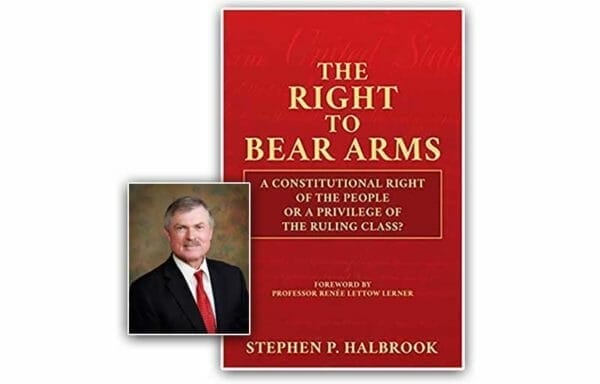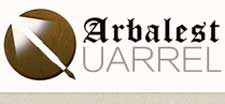
New York – -(AmmoLand.com)- Many Americans know Stephen Halbrook as a foremost legal expert on the Nation’s Second Amendment. It is a designation richly deserved, and his latest book, “The Right To Bear Arms,” couldn’t come at a more opportune and pressing time in our Nation’s history as the American people find themselves, at this moment, at a most perilous crossroads.
The central theme of Halbrook’s comprehensive, well-researched book is that the Second Amendment of the Bill of Rights of the U.S. Constitution is the linchpin of a free Constitutional Republic and of a sovereign people.
The Right To Bear Arms by Stephen P. Halbrook
Since the exercise of the “Right to Bear Arms” is the foundation for a free Constitutional Republic and a sovereign people, then the only reasonable inference to be drawn from a reading of “The Right To Bear Arms,” is that our Nation cannot continue to exist as a free Constitutional Republic with an American people as the sole and ultimate ruler of their Government, absent robust exercise of the right codified in the Second Amendment.
Exercise of the Right to Bear Arms is, then, not merely useful to the preservation of the Nation as a free Constitutional Republic and to an American people as the Nation’s sole sovereign, it is intrinsic to and therefore essential to the maintenance of both. Halbrook knows this, and his book is a forceful voice in the assent of this point.
Halbrook captures well, too, the imminent peril that besets the Country through the words that comprise the subtitle of his book. He poses the question:
“A Constitutional Right of the People or a Privilege of the Ruling Class?” The question, although merely rhetorical to Americans who cherish the Right, would be considered pertinent to those who don’t cherish it.
Framing the subtitle of the book as a question rather than as an exclamatory sentence is no accident or mere afterthought.
By posing the subtitle of his Book as a question Halbrook tells Americans they have an important—indeed, crucial—choice to make today, just as the framers of the Constitution had a crucial choice to make almost 250 years ago, when, after having emerged victorious after a hard-fought war for independence from tyranny, they found themselves faced with a new, similarly arduous task: hammering out the form of the central Government of the new Nation—the form of the U.S. Government—a “Federal” Government that would not eventually transform into a hideous, rapacious tyrant like the one they fought gallantly, and surprisingly to both their British adversary and other nations, to defeat.
The answer to the question, to whom does the Right to Bear Arms apply, was clear enough to the founders, but it was the import of the question that lay at the heart as to why the Right was etched in the Constitution. The framers of the Constitution had to acknowledge that the sanctity and well-being of a free Constitutional Republic and the sovereignty of the American people would rest, ultimately, less in the checks and balances, placed in the Articles of the U.S. Constitution, demarcating the distinct and limited roles of each of Three co-equal Branches, but in the incorporation of the “Right to Bear Arms” in the Constitution’s Bill of Rights.
And therein rests the singular importance of Halbrook’s latest book, “The Right To Bear Arms.” The main title of the book serves not only as an apt, brief descriptor of the nature of the content of the book but operates as the raison d’être for the author’s expenditure of significant time and effort to write it.
The “Right of the people to Bear Arms” is inextricably tied to the fate of the Country.
Lest there be any mistake, Halbrook makes clear at the outset to whom the inviolate Right to Bear Arms belongs. He writes,
“The Second Amendment refers to ‘the right of the people.’ And who are “the people?” The term ‘people,’ was defined as ‘persons’ in general . . . and the people was defined as ‘the commonalty,’ as distinct from men of rank. . . .”
The Right to Bear Arms, as understood by the framers of the Constitution, belongs, then, to the common people. It is not a thing to be enjoyed by and was never conceived by the framers of the Constitution, as a thing accruing to the benefit of a privileged few.
The underlying theme of the book is thus directed to the commendable task of staking a reasonable, rational claim for the “Right to Bear Arms” when legions of naysayers that control the Nation’s many airwaves, newspapers, periodicals, and social media organizations and enterprises, today, say otherwise.
But Halbrook also makes the pertinent point that the “Right to Bear Arms” always existed in the commonality.
The framers of the U.S. Constitution understood that the “Right to Bear Arms” is a preexisting right of the commoner. It was never perceived as a thing “invented” by the framers. Halbrook makes this point explicitly:
“‘the right of the people’ is significant. The term ‘right’ expresses a preexisting right, not a new right invented for the Bill of Rights. To declare that ‘the right’ to do or be free of something shall not be abridged, infringed, or violated presupposes that the right already exits.”
But what is one to make of the dependent “militia” clause?
Halbrook’s explanation might serve at once as a tacit and not so subtle remonstration directed to a remark by retired Associate Justice John Paul Stevens who has called at one point in time for outright repeal of the Second Amendment, knowing full well the plain meaning of it. Stevens has also suggested, in the alternative, that the language of the Second Amendment should be modified. In his book, “Six Amendments: How and Why We Should Change the Constitution,” the retired Associate Justice suggests altering the Second Amendment to read, “A well-regulated militia, being necessary to the security of a free state, the right of the people to keep and bear arms when serving in the militia shall not be infringed.”
The Framers would be aghast at the audaciousness of anyone, let alone a retired jurist, who would suggest tampering with the “Right to Bear Arms” and who would do so blatantly, shamelessly, who would dare deny to the people—the commonalty—the Right that properly belongs only to them, that exists inherently in them, and must remain always with them, to be exercised by them, in their individual capacity, without prior restraint, constraint, or condition.
As Halbrook states,
“If keeping and bearing arms was a ‘right’ only of the militia when in actual service, the Framers certainly would have so stated. It would have been odd when guaranteeing ‘the right of the people to keep and bear arms,’ had the Framers really meant ‘the right of the militia to keep and bear arms when authorized and activated by government.”
Much of Halbrook’s book details the history behind the Right and serves as an interesting backdrop to the imperative for it. The book makes for a fascinating read that brings us to the present day with the seminal Heller and McDonald case holdings that Halbrook also addresses.
At the end of the book, as one contemplates the captivating, indisputable facts detailed in it, one comes to an understanding of why the Right to Bear Arms must belong to the commonalty and must never be wielded by a privileged few.
Americans, the Nation’s commonalty, must remain true to their heritage or face subjugation, and stagnation and that will happen if they fall for deceptive, emotionally charged fallacious rhetoric.
The commonalty MUST INSIST on its PREEXISTENT innate Right to Bear Arms. It will lose everything the founders have bequeathed to them, and everything Americans have since fought and died for to keep, if they don’t insist on their preexistent Right to Bear Arms, endowed to them by the Loving, All-Powerful Creator.
It is either this or that: To Keep the Right or Lose The Right for all time. And there can be no compromise on this, no half measure.
One sees this clearly enough, and clearly laid out, upon a reading of “The Right To Bear Arms.” #ad
About The Arbalest Quarrel:
Arbalest Group created `The Arbalest Quarrel’ website for a special purpose. That purpose is to educate the American public about recent Federal and State firearms control legislation. No other website, to our knowledge, provides as deep an analysis or as thorough an analysis. Arbalest Group offers this information free.
For more information, visit: www.arbalestquarrel.com.

The post Halbrook’s “The Right To Bear Arms” More Than a Scholarly Treatise on RKBA appeared first on AmmoLand.com.
from https://ift.tt/3gAyo1A
via IFTTT


No comments:
Post a Comment